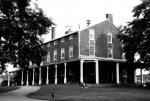Difference between revisions of "Portal:Featured Article Of The Week"
M-Explorer (talk | contribs) |
M-Explorer (talk | contribs) |
||
| (20 intermediate revisions by the same user not shown) | |||
| Line 1: | Line 1: | ||
{{FAformat | {{FAformat | ||
| − | |Title= | + | |Title= Carroll County Almshouse and Farm |
| − | |Image= | + | |Image= CarrollCountyAlmsHouse.jpg |
|Width= 150px | |Width= 150px | ||
| − | |Body= | + | |Body= When Carroll County was created by an act of the Maryland General Assembly in 1837, legislation was also passed to make Westminster the County Seat; to build a courthouse, a jail, a register's office, a clerk's office, and a poorhouse (almshouse). |
| − | + | It was the custom in 19th Century America to house the poor in a building called an almshouse since there was no welfare, housing subsidy, or food stamps as we have today. It was not until 1852 that the County Commissioners decided to borrow funds to build the Almshouse. A contract was made on July 6, 1852, for the purchase of 307 acres at a cost of $17,826 or $58.065 per acre. Records indicate that the Almshouse was built in 1852 and 1853. Public notice was given that paupers would be received on May 23, 1853. | |
| − | + | In the early years of the Almshouse, also called the "County Home," the chief position was the "Steward of the Almshouse," who was paid $400 yearly. Other workers included a Teamster at $150, a Fireman at $150, a Matron at $75, a Maid at $84, and a Washwoman at $75 yearly. | |
| + | |||
| + | At times as many as fifty people lived here. The Steward lived on the second floor and the women on the third floor. The men's dormitory sits at a right angle to the house. Residents who were able helped to work the farm to raise food for themselves. | ||
| + | |||
| + | People other than the poor from Carroll County lived here as well. It was a favorite stop for hobos and tramps. Sometimes the insane or criminals were placed here. Windows were barred in some rooms, and doors were lined with sheets of metal. [[Carroll County Almshouse and Farm|Click here for more...]] | ||
}} | }} | ||
Revision as of 04:55, 18 August 2019
Featured Article Of The Week
Carroll County Almshouse and Farm
When Carroll County was created by an act of the Maryland General Assembly in 1837, legislation was also passed to make Westminster the County Seat; to build a courthouse, a jail, a register's office, a clerk's office, and a poorhouse (almshouse).
It was the custom in 19th Century America to house the poor in a building called an almshouse since there was no welfare, housing subsidy, or food stamps as we have today. It was not until 1852 that the County Commissioners decided to borrow funds to build the Almshouse. A contract was made on July 6, 1852, for the purchase of 307 acres at a cost of $17,826 or $58.065 per acre. Records indicate that the Almshouse was built in 1852 and 1853. Public notice was given that paupers would be received on May 23, 1853.
In the early years of the Almshouse, also called the "County Home," the chief position was the "Steward of the Almshouse," who was paid $400 yearly. Other workers included a Teamster at $150, a Fireman at $150, a Matron at $75, a Maid at $84, and a Washwoman at $75 yearly.
At times as many as fifty people lived here. The Steward lived on the second floor and the women on the third floor. The men's dormitory sits at a right angle to the house. Residents who were able helped to work the farm to raise food for themselves.
People other than the poor from Carroll County lived here as well. It was a favorite stop for hobos and tramps. Sometimes the insane or criminals were placed here. Windows were barred in some rooms, and doors were lined with sheets of metal. Click here for more...
